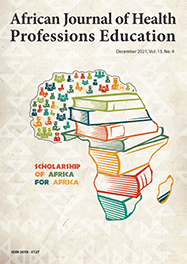Articles

Medical students' clerkship experiences and self-perceived competence in clinical skills
Abstract
Introduction. In a traditional curriculum, medical students are expected to acquire clinical competence through the apprenticeship model using the Halstedian ‘see one, do one, and teach one’ approach. The School of Medicine, University of Zambia, Lusaka, Zambia, used a traditional curriculum model from 1966 until 2011, when a competence-based curriculum was implemented.
Objective. To explore medical students’ clerkship experiences and self-perceived competence in clinical skills.
Methods. A cross-sectional survey was conducted among 5th-, 6th-, and 7th-year medical students at the School of Medicine, University of Zambia, two months before the final examinations. Students were asked to rate their clerkship experiences with regard to specific skills on a scale of 1 - 4 and their level of self-perceived competence on a scale of 1 - 3. Skills evaluated were in four main domains: history-taking and communication, physical examination and procedural skills, professionalism, teamwork and medical decision-making. Using the Statistical Package for the Social Sciences (SPSS), correlations were performed between experiences and self-perceived competence of specific skills, within domains and overall.
Results. Of clinical students (N=197), 138 (70%) participated in the survey. The results showed a significant increase in the proportion of students performing different skills and reporting feeling very competent with each additional clinical year. Overall correlations between experience and self-perceived competence were moderate (0.55). For individual skills, the highest correlation between experience and self-perceived competence was observed mainly with regard to medical- and surgical-related procedural skills, with the highest at 0.82 for nasogastric tube insertion and 0.76 for endotracheal intubation.
Conclusion. Despite the general improvement in skills and self-perceived competence some deficiencies were noted, as significant numbers of final-year students had never attempted important common procedures, especially those performed in emergency situations. Deficiencies in certain skills may call for the incorporation of teaching/learning methods that broaden students’ exposure to such skills.
Authors' affiliations
Patricia Katowa-Mukwato, Department of Medical Education Development and Department of Nursing Sciences, School of Medicine, University of Zambia, Lusaka, Zambia
Ben Andrews, Department of Internal Medicine, School of Medicine, University of Zambia, Lusaka, Zambia and Department of Internal Medicine, Vanderbilt University, Nashville, Tennessee, USA
Margaret Maimbolwa, Department of Nursing Sciences, School of Medicine, University of Zambia, Lusaka, Zambia
Shabir Lakhi, Department of Internal Medicine, School of Medicine, University of Zambia, Lusaka, Zambia
Charles Michelo, Department of Public Health, School of Medicine, University of Zambia, Lusaka, Zambia
Yakub Mulla, Department of Surgery, School of Medicine, University of Zambia, Lusaka, Zambia
S S Banda, Department of Medical Education Development, School of Medicine, University of Zambia, Lusaka, Zambia
Full Text
Keywords
Cite this article
Article History
Date published: 2014-07-30
Article Views
Full text views: 3710




.jpg)
Comments on this article
*Read our policy for posting comments here